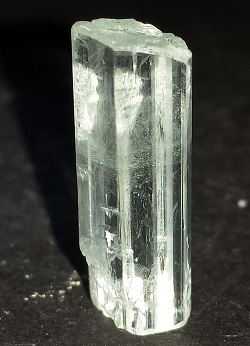A- |
B- |
C- |
D- |
E- |
F- |
G- |
H- |
I- |
J- |
K- |
L- |
M- |
N- |
O- |
P- |
Q- |
R- |
S- |
T- |
U- |
V- |
W- |
X- |
Y- |
Z |
AQUAMARINE:PHYSICAL CHARACTERISTICS:VARIETY OF: Beryl , Be3 Al2 Si6 O18. USES: Gemstone. BIRTHSTONE FOR: March. COLOR: various shades of blue to blue-green. INDEX OF REFRACTION: 1.57 - 1.60. HARDNESS: 7.5 - 8. CLEAVAGE: one direction, poor. CRYSTAL SYSTEM: hexagonal. Aquamarine is the blue, or perhaps more correctly, blue-green or aqua variety of the mineral beryl. Other gemstone color varieties that are also the mineral beryl include emerald, morganite, and heliodor. Other colors of beryl are simply referred to by their color, such as red beryl. Aquamarine is colored by trace amounts of iron. Most gem aquamarines have been heat treated to produce the popular blue-green colors from less desirable yellow or pale stones. The leading producer of aquamarines is the country of Brazil, which has many mines. Pakistan, as well as many U.S. localities, produce wonderful specimens as well. Recently, a new mine in China has produced large numbers of excellent flat (stubby) hexagonal crystals, for a fraction of the price of those beautiful Pakistan specimens. Aquamarine is sometimes found in huge crystals (unlike emerald). It is also known in a glassy form, often without showing crystal form, and sometimes with many holes or other odd shapes. Other times a large cluster of prismatic crystals can be seen to all have the same alignment - a sign that it is really a single crystal with many faces. Aquamarine often forms perfect, flawless crystals - also unlike Emerald for which flawless natural crystals are extremely rare. |

